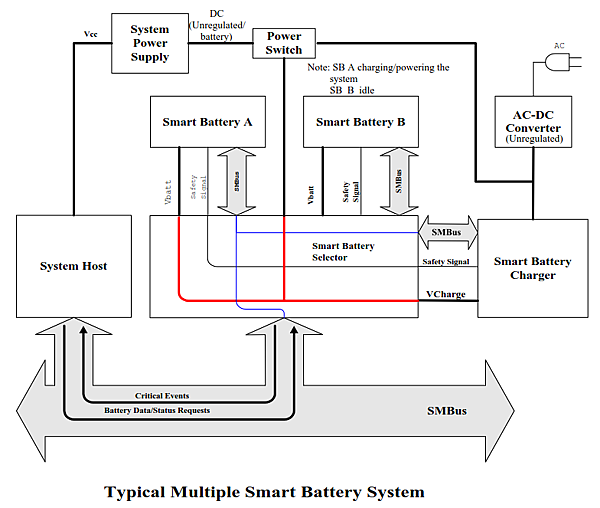為避免篇幅太長,把第4章分成兩半
對翻譯有疑問請參照前篇說明
====
4.2. Smart Battery Selector Model 智能電池選擇器模型
One possible Smart Battery Selector model is a system consisting of two batteries and smart battery charger in a notebook computer. The diagram below illustrates the typical power and data paths when battery A is acting as the primary battery.
一種可能的智能電池選擇器模型,是一個由筆記本電腦中的兩個電池和智能電池充電器組成的系統。 下圖說明了當電池A作為主要電池時的典型電源和數據路徑。
This diagram shows a Smart Battery Selector connecting Smart Battery A to both the system and the charger. When AC is present, the Smart Battery can opt to charge itself as required and the system will be powered by the AC source (no power will be drawn from the battery terminals). If AC is not present, the system will be powered by Smart Battery A.
此圖顯示了一個將智能電池A連接到系統和充電器的智能電池選擇器。 當使用交流電時,智能電池可以選擇根據需要自行充電,而系統將由交流電源供電(不會從電池端取電)。 如果不存在交流電,則系統將由智能電池A供電。

The following diagram presents a variation where Smart Battery A is available to power the system, while Smart Battery B is connected to a charger and being conditioned. Although this is not the most common connection nor necessarily supported by all selectors, it is useful in situations where one battery requires a conditioning cycle while the system must be fully ready to operate.
下圖顯示了一個變體,其中智能電池A可用於為系統供電,而智能電池B已連接至充電器,並進行調節(condition)。 雖然這不是最常見的連接,也不一定受所有選擇器支持,當系統必須準備就緒以進行運作,電池需要一個調節循環的情況下,這是很有用的。(翻譯可能有誤,自行參酌)

4.3. Interface Requirements 介面要求
The software interface consists of the primary read/write control register, an optional read/write control register, and a read-only register. The selector is defined as an SMBus slave-only device, however, it would be possible to construct a device that behaves as a master and sends its SelectorState() to the SMBus host after every change.
該軟體介面由主要的讀/寫控制暫存器,可選的讀/寫控制暫存器,和一個唯讀暫存器組成。 選擇器被定義為SMBus slave-only 裝置,但是,有可能建構一個裝置,在每次更動後,其充當主設備(master),將其SelectorState()發送到SMBus主機。
4.4. Smart Battery Selector Functional Requirements
智能電池選擇器功能要求
The Smart Battery Selector should provide the following services:
智能電池選擇器應該提供以下服務:
• The selector will do a power-on default to connect one battery to power the system and can optionally also connect a battery to the charger.
•選擇器要執行上電預設,以連接一個電池來為系統供電,並且還可以選擇性地將一個電池連接到充電器。
• The selector will monitor the active battery’s terminal voltage and if it falls below a preset minimum, autonomously switch to another battery (if one is present). The selector will update its SelectorState() register to reflect the change and notify the system that its SelectorState has changed.
Care should be taken to avoid a situation where the selector “oscillates” between batteries when there are multiple depleted batteries in the system. In this case, it is acceptable for the selector to disconnect all the batteries from the system power supply, effectively shutting down the system.
•選擇器將監視活動電池的端電壓,如果它掉到低於預設的最小值,選擇器自動切換到另一個電池(如果有的話)。 選擇器將更新其SelectorState()暫存器,以反映更改(改動),並通知系統其SelectorState已更改。 應當注意避免的情況是:當系統中有多個電池電量耗盡時,選擇器在多個電池之間之間『振盪』的情況。 在這種情況下,選擇器可以斷開(disconnect)所有系統電源中的電池,有效地關閉掉系統。
• The selector will monitor the presence of the active battery and, if it is removed, autonomously switch to another battery (if one is present). The selector will update its SelectorState() register to reflect the change and notify the system that its SelectorState has changed.
•選擇器將監視活動電池的存在,如果被移除,則選擇器會自動切換連接到另一個電池(如果有的話)。 選擇器將更新其SelectorState()暫存器,以反映更改(改動),並通知系統其 SelectorState 已更改。
• If the system is being powered by AC (POWERED_BY_X set to 0) and AC is removed, the selector will autonomously switch to the next viable battery, update its SelectorState() register to reflect the change, and notify the system that its SelectorState has changed.
•如果系統由交流電供電(POWERED_BY_X設置為0),並且交流電已移除,則選擇器
將自動切換到下一個可用的(viable)電池,更新其SelectorState()暫存器以反映更改,並通知系統其SelectorState已更改。
• If the optional SelectorPresets()’s USE_NEXT_X register is supported, the selector will give highest priority to the indicated battery on its next autonomous battery switch.
•如果可選的SelectorPresets()的USE_NEXT_X暫存器被支援(support),則選擇器將提供最高優先級給在其下一個自動電池開關上的指定的電池。(翻譯可能有誤,自行參酌)
• The charger connection remains until changed by the SMBus Host while the host system is operational. This is true even when the battery connected to the charger is removed or added.
•在主機系統運行時,充電器連接將一直保持,直到被SMBus主機(Host)更改為止。
即使當連接至充電器的電池被移除或加入時,也是如此。
• The battery selector must report whether AC is present or not, and if it changes, the selector will update its SelectorState() register to reflect the change and notify the system that its SelectorState has changed.
•電池選擇器必須報告是否存在交流電,如果交流電發生變化,則選擇器將更新
其SelectorState()暫存器,以反映了更,並通知系統其SelectorState已更改。
• Whennever the battery selector encounters a valid command with invalid data, it is expected to do nothing and just ignore the data. For example, if an attempt is made to select battery A and B to simultaneously power the system, the selector will just ignore the request. Another example might be a request to connect battery A to the charger and also select battery A to power the system; the selector should also recognize this as an invalid command. This behavior will help to prevent errant commands for setting up conditions that might cause damage to the system, user, or battery.
•每當電池選擇器遇到帶有無效數據的有效命令時,都應該單純忽略數據,什麼都不做。
例如,如果試圖選擇電池A和B來同時為系統供電,選擇器將忽略該請求。
另一個例子是:請求將電池A連接至充電器,並且選擇電池A為系統供電;選擇器也應該將其識別為無效命令。 此行為將有助於防止設置可能會損傷系統、用戶或電池的錯誤命令(errant commands)。
• Optionally, it is desirable for there to be some mechanism for the selector to operate in an autonomous manner, independent of high-level control such as that provided by an application or system BIOS, thus allowing the system to charge multiple batteries while the host intelligence is not operational (e.g., when the system is off or suspended). This can be accomplished in many ways, for example: a control bit in one of the Selector’s optional OptionalMfgRegister registers, a pin monitoring the system’s suspend status signal, or keeping the host alive whenever there is charging power available.
•作為選項之一,若有某些機制可以使選擇器以自動的方式運行,獨立於高階控制之外(例如由應用程序或系統BIOS提供的控制),因而允許系統在主機智能無法運行時為多個電池充電(例如,系統關閉或暫停(suspended)時),這種機制也是很好的(desired)。這可以通過多種方式實現,例如:選擇器的可選OptionalMfgRegister暫存器之一的一個控制位元,或用於監視系統的暫停狀態信號的腳位,或者在有可用充電電源時使主機保持活動狀態。
In all cases, the selector’s primary purpose is to maintain system power AND minimize interruptions to that power. Its secondary purpose is to inform (or make information available to) the SMBus host about the system’s battery SelectorState and changes in that SelectorState.
在所有情況下,選擇器的主要目的是保持系統電源,並且,最大程度地減少對系統的干擾系統電源。 其次要目的,是通知SMBus主機(或使資訊可被取得)關於系統電池的SelectorState,以及該SelectorState中的更改。


 留言列表
留言列表


